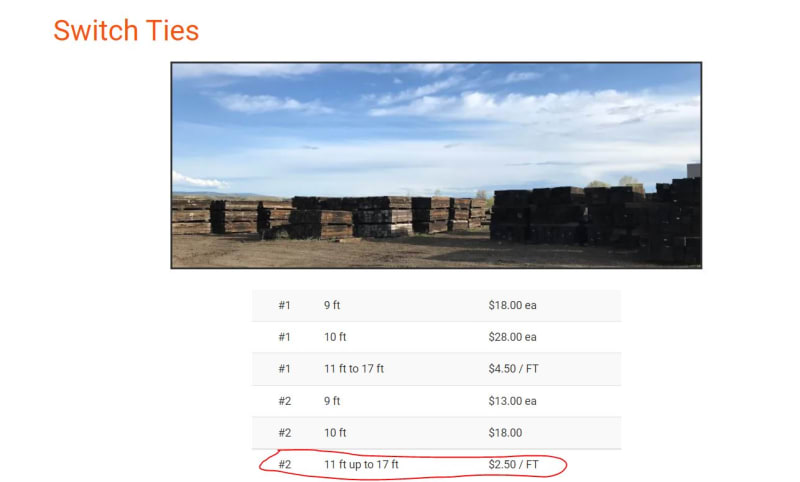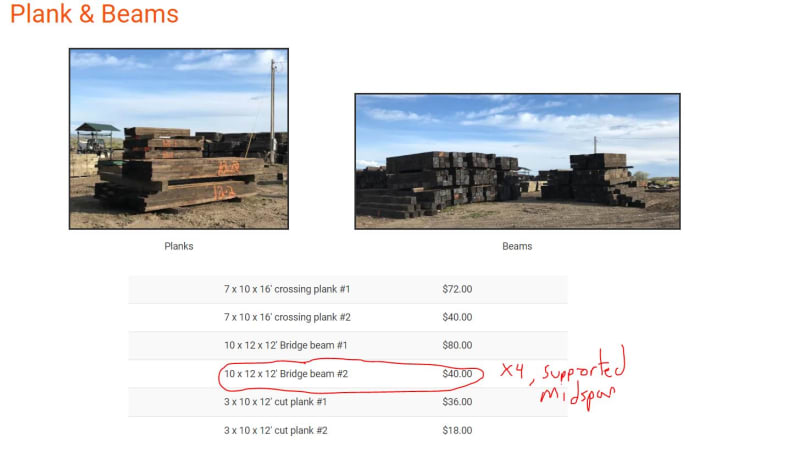miamicuse
Civil/Environmental
- Nov 12, 2011
- 22
I have a small wood bridge over a pond at my property that needs replacement.
The existing structure has a span of 17 feet, 42" wide. The deck are all 2X4s, the substructure is three pieces of 2X6s at 0, 20", 40". The 2X6s are sitting on grout filled concrete blocks at each end, and a stack of concrete blocks in the middle about 9' from each end. Also these are not single piece 2X6s spanning the 17.5' length, they are connected at the middle support stack of blocks with a short piece of 2X6s sistered from the inside.
This bridge has been there since 1992 and was erected by the previous home owner, but is completely rotted at this point it is unsafe to walk on. The pond is only two feet deep. Location is Miami, Florida, very hot and humid, rains a lot, occasional floods.
Here are some pictures of the bridge taken last year, it is still seemingly in good shape, but the 2X6s underneath are not.
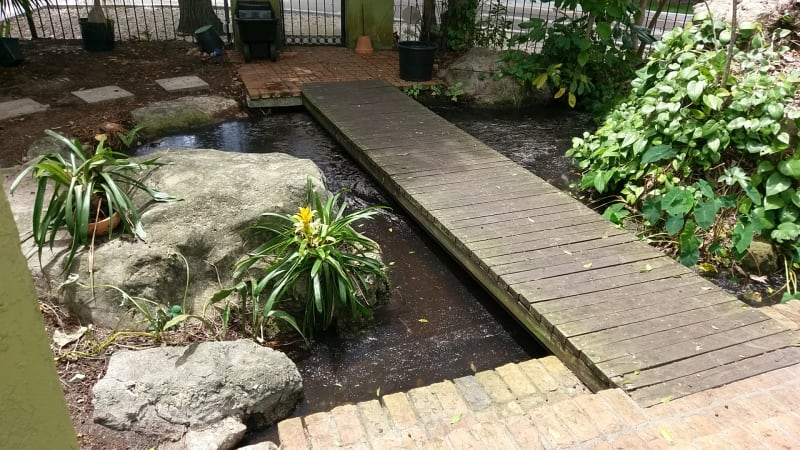
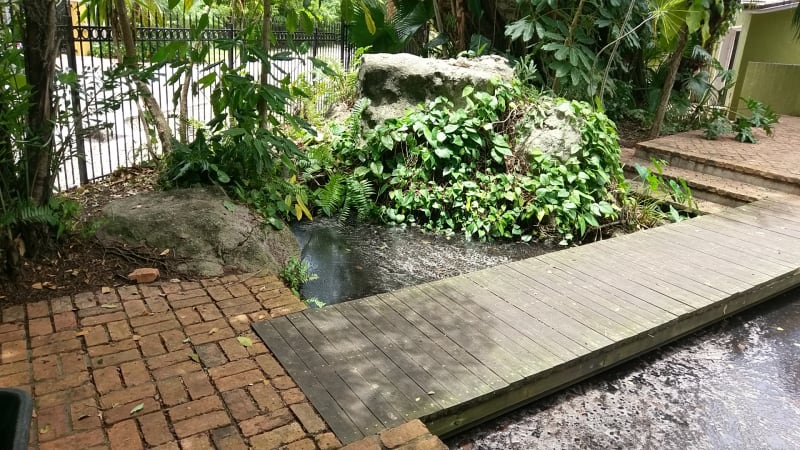
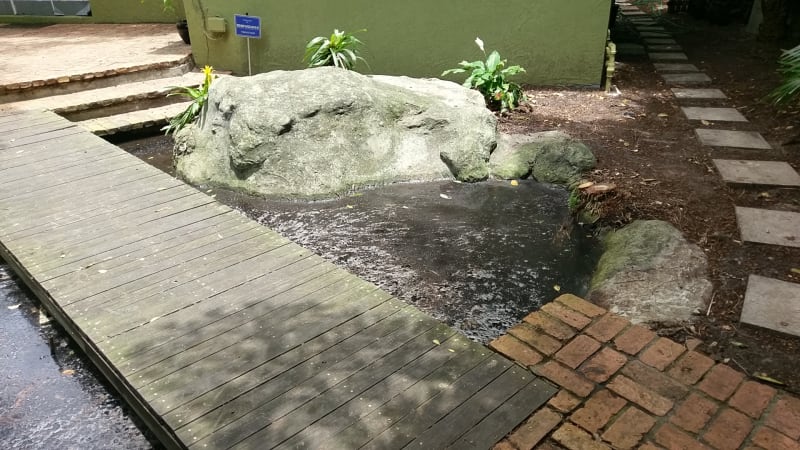
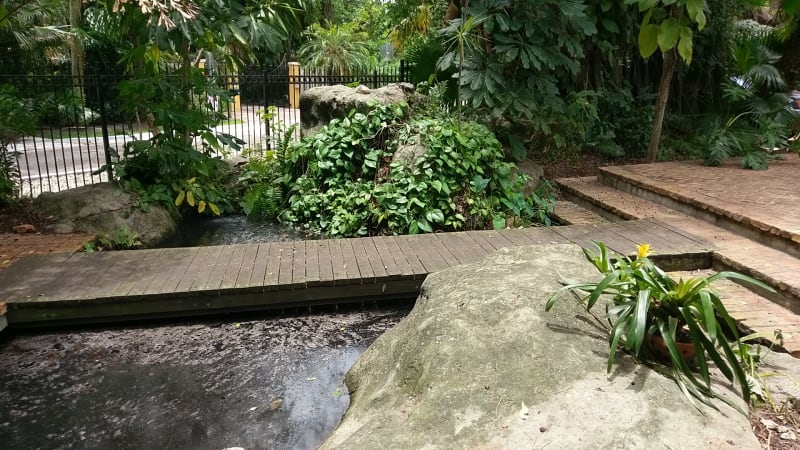
I am going to be draining the pond in order to repair/replace some plumbing pipes at the bottom of the pond, and will be also replacing the bridge.
I am planning on using 2X6s like the old design, but with full length 2X6s cut down from 20' stock. I will also double the 2X6s, in other words, double 2X6s at one side, double 2X6s in the middle (about 20" in), and double 2X6s at the other side, with 40" 2X4s at the top.
My biggest issue is the wood rot of the 2X6s. It is amazing (to me at least) that this bridge lasted 30 years. I tried looking for ways to maximize it's useful life.
(1) composite materials - I know composite decking is a trend now, where the advantage is no wood rot. However, all these composite decking are still sitting on lumber. So while the top of the deck may be rot free, it does not solve the problem of the framing materials below.
(2) rot and insect resistant hard wood - I looked at using some exotic hard wood such as IPE, those are virtually indestructable. However, they are incredibly expensive (even regular lumber is 4X "normal" prices right now) and they are very hard to work with. I took home some sample pieces and they do not drill well. They will require special bits and predrilling holes, my regular wood drill bit smoked trying to drill into it. You also need special screws with them, and they are HEAVY.
(3) better "treated" building lumber. Since 2004 typical pressure treated lumber has gone from being CCA treated to ACQ treated, and ACQ is more environmental friendly. However I have also seen numerous feedback from local tradesmen here that ACQ lumber rots much much faster. I went to a marine deck & dock supplier locally and they carry a 0.6CCA treated lumber said this is rated for critical structures that may get occasionally water splashes. So right now I leaning on using this material.
Which leads to my specific questions below.
(1) It is stated that pressure treated lumber is very corrosive to metal fasteners. The old bridge used galvanized nails. I am planning to use screws. What would perform better? Stainless steel screws or ceramic coated screws?
(2) I noticed many contractors are using joist tape to wrap the top edge of the substructure where it may contact the underside of the decking materials. The reason is to prevent moisture penetration. I see it used on decks, I have seen it applied to stairs, I have seen it wrapped around the bottom of fence posts where it meets soil. I would like some opinion on joist tapes, are they really effective in prolonging the life of lumber that are exposed to the elements? Here are some pictures of joist tape. Those engineers who deal with residential constructions do you spec joist tapes for decks, wood stairs and fence posts?
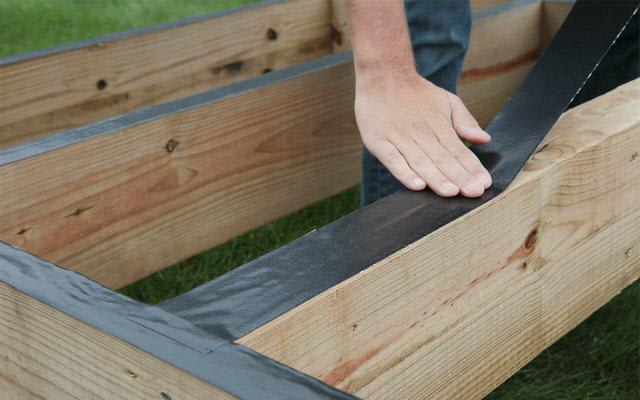
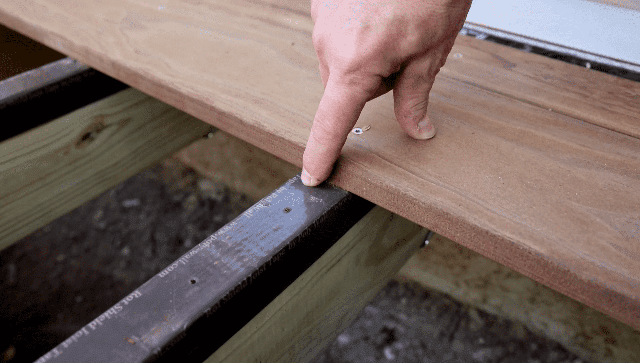
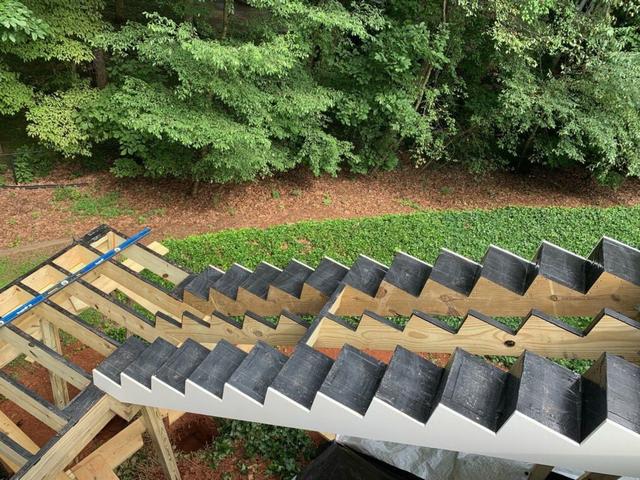
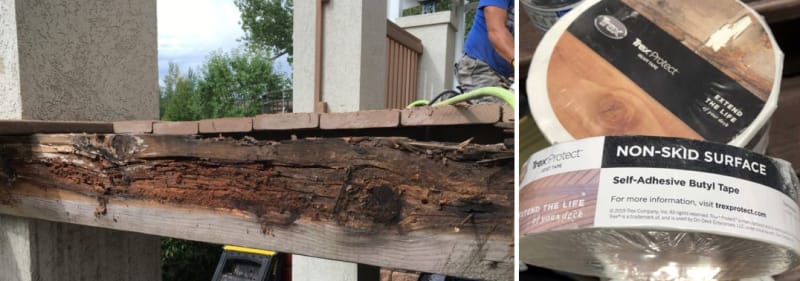

(3) To my amazement, the current bridge is not connected to anything. All the concrete blocks it is sitting on, the lumber and the concrete are not connected. No straps, no fasteners, no brackets of any kind. It's just gravity. I know because I went into the pond and lifted one end of it up. Do I need some kind of connections? If so what kind? Simpson's Strong Ties has some concrete to timber connection brackets I can consider, but I do not know if they can be used if the connector may be subject to water immersion occasionally.
Thanks in advance for any comment. I also want to apologize if this is posted in the wrong forum, I see there is a bridge engineering forum and this is indeed a bridge, but the context is different and I am not asking so much about a bridge but about weatherproofing.
The existing structure has a span of 17 feet, 42" wide. The deck are all 2X4s, the substructure is three pieces of 2X6s at 0, 20", 40". The 2X6s are sitting on grout filled concrete blocks at each end, and a stack of concrete blocks in the middle about 9' from each end. Also these are not single piece 2X6s spanning the 17.5' length, they are connected at the middle support stack of blocks with a short piece of 2X6s sistered from the inside.
This bridge has been there since 1992 and was erected by the previous home owner, but is completely rotted at this point it is unsafe to walk on. The pond is only two feet deep. Location is Miami, Florida, very hot and humid, rains a lot, occasional floods.
Here are some pictures of the bridge taken last year, it is still seemingly in good shape, but the 2X6s underneath are not.




I am going to be draining the pond in order to repair/replace some plumbing pipes at the bottom of the pond, and will be also replacing the bridge.
I am planning on using 2X6s like the old design, but with full length 2X6s cut down from 20' stock. I will also double the 2X6s, in other words, double 2X6s at one side, double 2X6s in the middle (about 20" in), and double 2X6s at the other side, with 40" 2X4s at the top.
My biggest issue is the wood rot of the 2X6s. It is amazing (to me at least) that this bridge lasted 30 years. I tried looking for ways to maximize it's useful life.
(1) composite materials - I know composite decking is a trend now, where the advantage is no wood rot. However, all these composite decking are still sitting on lumber. So while the top of the deck may be rot free, it does not solve the problem of the framing materials below.
(2) rot and insect resistant hard wood - I looked at using some exotic hard wood such as IPE, those are virtually indestructable. However, they are incredibly expensive (even regular lumber is 4X "normal" prices right now) and they are very hard to work with. I took home some sample pieces and they do not drill well. They will require special bits and predrilling holes, my regular wood drill bit smoked trying to drill into it. You also need special screws with them, and they are HEAVY.
(3) better "treated" building lumber. Since 2004 typical pressure treated lumber has gone from being CCA treated to ACQ treated, and ACQ is more environmental friendly. However I have also seen numerous feedback from local tradesmen here that ACQ lumber rots much much faster. I went to a marine deck & dock supplier locally and they carry a 0.6CCA treated lumber said this is rated for critical structures that may get occasionally water splashes. So right now I leaning on using this material.
Which leads to my specific questions below.
(1) It is stated that pressure treated lumber is very corrosive to metal fasteners. The old bridge used galvanized nails. I am planning to use screws. What would perform better? Stainless steel screws or ceramic coated screws?
(2) I noticed many contractors are using joist tape to wrap the top edge of the substructure where it may contact the underside of the decking materials. The reason is to prevent moisture penetration. I see it used on decks, I have seen it applied to stairs, I have seen it wrapped around the bottom of fence posts where it meets soil. I would like some opinion on joist tapes, are they really effective in prolonging the life of lumber that are exposed to the elements? Here are some pictures of joist tape. Those engineers who deal with residential constructions do you spec joist tapes for decks, wood stairs and fence posts?





(3) To my amazement, the current bridge is not connected to anything. All the concrete blocks it is sitting on, the lumber and the concrete are not connected. No straps, no fasteners, no brackets of any kind. It's just gravity. I know because I went into the pond and lifted one end of it up. Do I need some kind of connections? If so what kind? Simpson's Strong Ties has some concrete to timber connection brackets I can consider, but I do not know if they can be used if the connector may be subject to water immersion occasionally.
Thanks in advance for any comment. I also want to apologize if this is posted in the wrong forum, I see there is a bridge engineering forum and this is indeed a bridge, but the context is different and I am not asking so much about a bridge but about weatherproofing.

